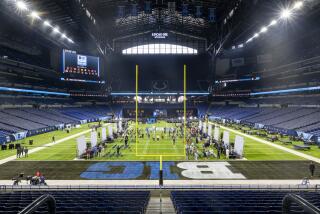Lowering our expectations for foreclosure settlement
The federal government’s response to the home mortgage crisis always has been an exercise in living down to one’s lowest expectations.
The $25-billion settlement with five big banks over foreclosure abuses that U.S. housing officials and 49 state attorneys general announced last month was supposed to be an exception. Here, at last, was real compensation from those who played key roles in the disaster.
But with every passing day, the shortcomings of this deal appear to proliferate. That is, as far as we know, because the specific terms of the settlement are still not public, nearly one month after it was unveiled in Washington with the sort of fanfare formerly associated with the splashdown of a space capsule.
The latest explanation for the secrecy is that the parties are waiting until the settlement is filed with a federal court in Washington, which could happen this week or next. But the explanation only evades the question of why the deal wasn’t filed in court before or simultaneously with the big dog-and-pony show, as is customary with high-profile legal settlements.
It’s fair to say that there are positive aspects to the settlement. It creates some incentives for the five banks — Bank of America, Wells Fargo, JPMorgan Chase, Citigroup and Ally Financial (the former GMAC) — to be more aggressive in offering relief to strapped borrowers whose home values have fallen below their mortgage balances.
For each variety of mortgage relief, the banks will get a certain credit against their $20-billion target. For every dollar of balance reduction offered a homeowner who is up to 75% underwater, for example, they get a dollar credit; for principal forgiveness on delinquent home-equity lines, the credit ranges from 10% to 90%.
“We’ve got a frozen housing market,” observes Arthur Wilmarth, a banking expert at George Washington University Law School. “If we can unfreeze it to some extent and still make the banks feel some pain for what they’ve done, that’s not a bad result.”
California Atty. Gen. Kamala D. Harris also extracted special consideration for the state, which with 26% of the nation’s negative housing equity is the deepest-underwater state in the union.
Despite the secrecy shrouding the overall deal, it does appear that the California-specific provisions in the settlement require BofA, JPMorgan Chase and Wells Fargo to meet a $12-billion target in California homeowner relief. State officials believe that the provisions will encourage the banks to do more writing down of principal balances on underwater loans than they will in the rest of the country, front-load the relief more into the first year of the agreement, and to focus more on 12 particularly hard-hit counties.
Yet some troubling aspects that emerged when the settlement was unveiled Feb. 9 look even worse a month later. One is how federal regulators are helping the banks meet the costs of the settlement. The Office of the Comptroller of the Currency, a major bank regulator, said on the very day of the settlement announcement that it was giving the five banks in the deal a pass on $394 million in penalties it would otherwise have assessed them for shoddy, and shady, mortgage and foreclosure practices.
It turns out that two other federal regulators quietly took similar steps. The Federal Reserve Board rolled $766.5 million of penalties it assessed the banks for unsafe and unsound mortgage practices into the foreclosure settlement. And just last week, the Treasury Department announced that it would pay BofA and JPMorgan Chase some $171 million in incentives it had withheld since June because of the banks’ shortcomings in dealing with homeowners under the government’s chronically underperforming Home Affordable Modification Program, or HAMP.
The comptroller’s office and Fed write-downs are predicated on the banks’ meeting their obligations under the foreclosure deal. The idea is that the banks will have to take actions valued at as least as much as the penalties being waived. BofA, for example, was assessed $175.5 million in sanctions by the Fed. If it attains credits of $175.5 million under the foreclosure settlement by modifying borrowers’ loans and taking other steps, it will owe the Fed nothing.
You might think that means the banks will be required to amass $1.16 billion in credits to satisfy the bills presented by the Fed and the comptroller’s office. Nope. It’s possible that the banks will be permitted to apply one dollar of performance to both sets of sanctions, which means they may be on the hook for only $766.5 million.
The Fed says it will be up to the comptroller’s office to decide whether to apply a credit that the Fed has already accepted, but a spokesman for the comptroller’s office says the agency thinks that could be all right. We won’t know until the detailed terms are made public, if then.
As for the Treasury, it hasn’t made clear what obligations it will impose on BofA and JPMorgan in return for its paying the withheld cash incentives, if any. It does say it will continue to keep an eye on the banks’ compliance with HAMP rules, which I’m sure strikes terror into the hearts of the bankers who were consistently flouting them before.
You can argue to your heart’s content about whether these penalties were justified and whether the absolution was necessary to bring the banks to the table, but one fact is indisputable: If the banks had shown as much forbearance toward their struggling borrowers as these three agencies have shown toward the banks, the foreclosure settlement wouldn’t have been necessary in the first place.
Another murky question involves the number of homeowners who may be helped with mortgage relief. Initial estimates from the state and federal negotiators placed that figure at 2 million families. This always seemed a bit on the high side, especially since mortgages owned by the government-sponsored companies Fannie Mae and Freddie Mac, which hold more than half the nation’s underwater mortgages, aren’t participating in the deal.
Brookings Institution analyst Ted Gayer last week concluded that other carve-outs will limit the number to 500,000 of the nation’s 11 million underwater borrowers. Among other points, he observes that the five participating banks service only 55% of all mortgages.
The settlement’s worst flaw may be that it’s a lost opportunity. It could have been used to improve HAMP, say by mandating that the banks offer HAMP-eligible borrowers principal forgiveness, which studies show is the most effective way to keep borrowers out of foreclosure. Under current HAMP rules, such offers are optional. But such a provision would have countered the perverse incentives in the mortgage business that discourage mortgage servicers, including the five banks in the settlement, from helping homeowners avoid foreclosure.
“That would have been in everybody’s interest,” says Neil Barofsky, the former inspector general for the government’s bank bailout, which included HAMP.
The aspect of the lost opportunity is that the settlement, to the extent it inflicts any pain on the banks, does so entirely at the institutional level.
“What’s most discouraging is that you see none of the individuals who were driving these things being held in any way accountable,” Wilmarth says. “The only thing that will actually change behavior going forward is for the individuals who were at the center of this to be held personally responsible and be forced to give up their ill-gotten gains. Then maybe their successors might think twice.”
Michael Hiltzik’s column appears Sundays and Wednesdays. Reach him at mhiltzik@latimes.com, read past columns at latimes.com/hiltzik, check out facebook.com/hiltzik and follow @latimeshiltzik on Twitter.
More to Read
Inside the business of entertainment
The Wide Shot brings you news, analysis and insights on everything from streaming wars to production — and what it all means for the future.
You may occasionally receive promotional content from the Los Angeles Times.











